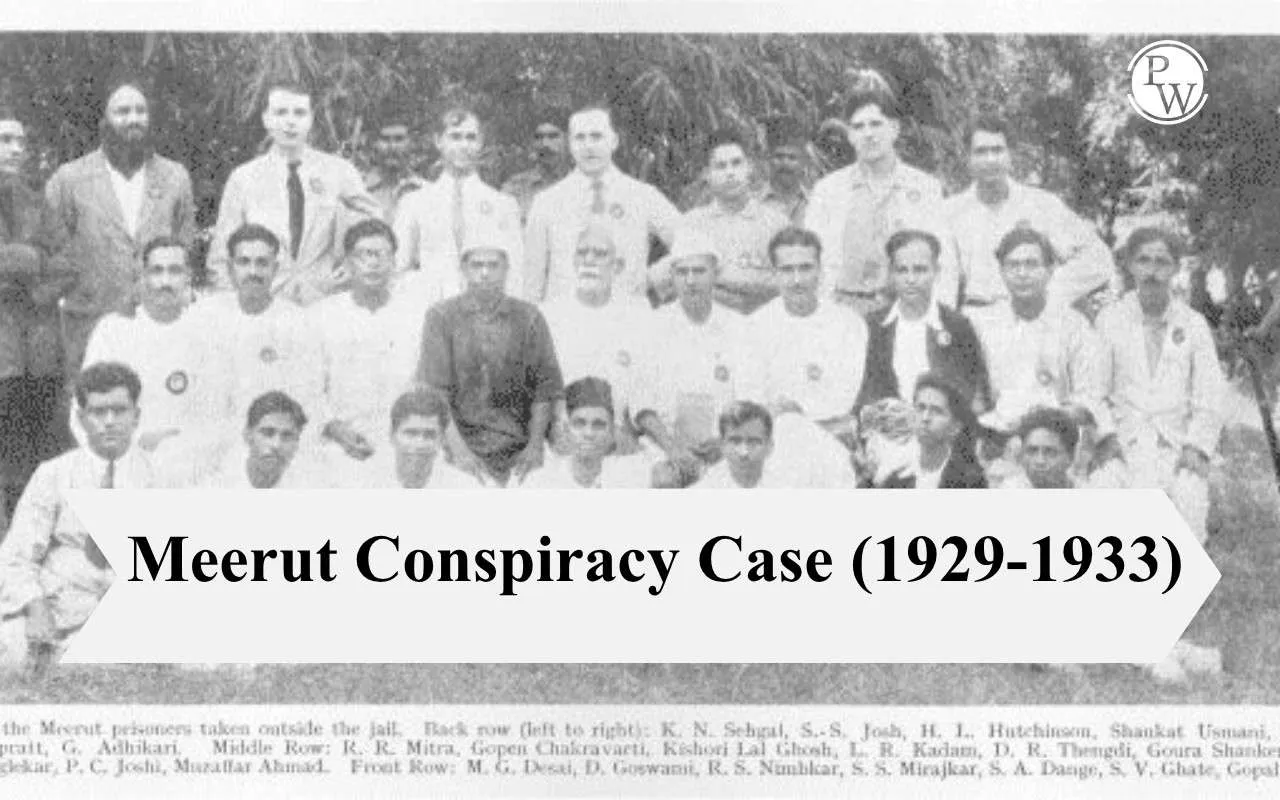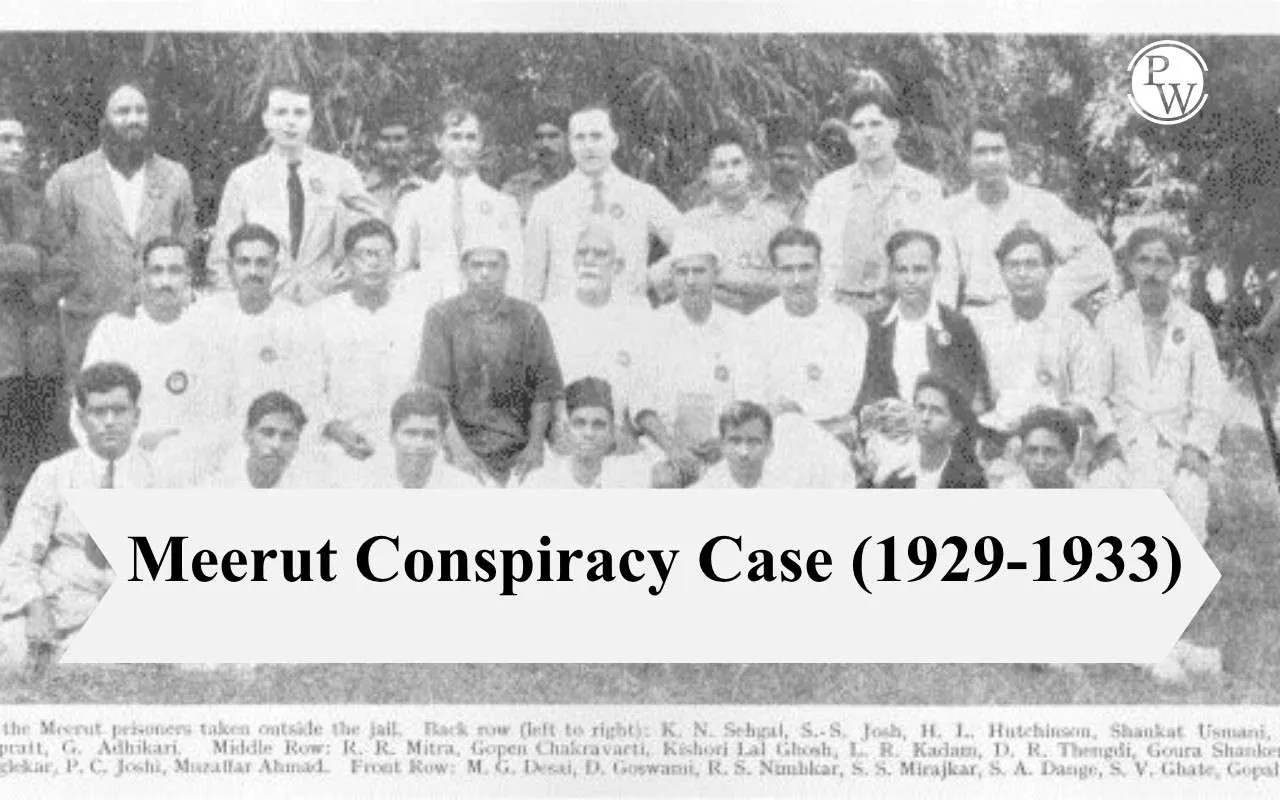

Meerut Conspiracy Case is a significant event in the history of India's national liberation struggle, highlighting the growing influence of communist ideology and trade unionism against the British Raj.
Initiated in March 1929 and decided in 1933, this controversial court case saw the arrest and prosecution of several prominent labour and communist leaders.
The British government perceived the rise of communist-led worker and peasant movements as a direct threat to its rule. The resulting trial, far from suppressing the movement, ultimately provided an immense platform for the propagation of communist and socialist ideas across India.
What is Meerut Conspiracy Case?
Meerut Conspiracy Case was a controversial political trial launched by the British government in India to curb the growing communist movement and the associated trade union activities.
-
Meerut Conspiracy Case Year: The trial began with the arrest of the accused on March 20, 1929, and the final judgment was delivered in January 1933.
-
Location: Meerut, Uttar Pradesh, was strategically chosen by the authorities to avoid a trial by jury, which would have been customary in major centres like Bombay or Calcutta.
-
Charge: The accused were charged under Section 121-A of the Indian Penal Code, which deals with conspiracy to deprive the King-Emperor of the sovereignty of British India.
-
Accused: A total of 31 leaders were arrested, including prominent Indian communists, trade unionists, and three British communists.
Background and Causes of the Meerut Conspiracy Case 1929
Meerut Conspiracy Case was an outcome of the British government's fear regarding the consolidation and expansion of leftist politics and labour unrest in the late 1920s.
-
Rise of Communism and Trade Unionism: Following the failure of the Non-Cooperation Movement, the socialist and communist-led labour movement gained momentum. Leaders like S.A. Dange and Muzaffar Ahmad were instrumental in establishing branches of the Communist International in India and organising the working class.
-
Formation of Workers and Peasants Parties: The communists, along with others, formed Workers' and Peasants' Parties in major cities like Bombay, Bengal, and Punjab. The WPP's activities contributed to growing awareness among the masses, linking the independence struggle with the worldwide anti-imperialist movement.
-
Militant Labour Strikes: The late 1920s witnessed intense labour struggles and widespread strikes, particularly in the railway sector, which worried the colonial administration. The British government believed the ultimate objective of the communist conspiracy was the complete paralysis and overthrow of existing Governments in every country, including India, by means of a general strike and armed uprising.
-
British Fear: The global context of the Great Depression and the tremendous progress made by the newly formed socialist state of Soviet Russia further intensified the British government's anxiety over the spread of revolutionary communist ideas. The case was explicitly aimed at suppressing the communist movement in its early stages.
Key Figures Involved in the Meerut Conspiracy Case
A total of 31 leaders were arrested on March 20, 1929, under the Viceroyalty of Lord Irwin.
|
Key Figures Involved in the Meerut Conspiracy Case |
||
|
Category |
Key Leaders Arrested |
Role/Affiliation |
|
Indian Communists |
S.A. Dange, Muzaffar Ahmad, Shaukat Usmani (previously tried in the Kanpur Conspiracy Case, 1924) |
Members of the Communist Party of India (CPI) and leaders of the trade union movement |
|
S.V. Ghate, K.N. Joglekar, R.S. Nimbkar, P.C. Joshi, S.S. Mirajkar, Sohan Singh Josh |
Prominent figures in the labour movement and executive members of the WPP |
|
|
British Communists |
Philip Spratt, Benjamin Francis Bradley (B.F. Bradley), H.L. Hutchinson |
Sent to India by the Communist Party of Great Britain to aid the communist movement |
Trial Proceedings and Outcome
The trial was one of the most prolonged and expensive judicial proceedings in British India, lasting nearly four and a half years.
-
Proceedings: The case commenced on March 15, 1929. The preliminary proceedings took seven months, and the commitment to the Court of Sessions occurred on January 14, 1930. The entire process involved 3,500 prosecution exhibits and over 320 witnesses.
-
Defense Strategy: Unlike in previous communist conspiracy cases, the defendants decided to use the courtroom as a public platform to articulate and propagate their communist agenda and political beliefs.
-
Sessions Court Verdict (January 1933): The Sessions Court convicted 27 out of the 32 accused with stringent sentences, including life transportation for Muzaffar Ahmad and 12 years' transportation for Dange, Spratt, Ghate, Joglekar, and Nimbkar.
-
High Court Appeal (August 1933): The 27 convicts appealed to the Allahabad High Court. The High Court, presided over by Chief Justice Sir Shah Muhammad Sulaiman, upheld the convictions but drastically reduced the sentences for most and acquitted nine of the accused.
Significance and Impact of the Meerut Conspiracy Case
Though intended to suppress the growing communist movement, the Meerut Conspiracy Case became a turning point, ultimately strengthening the movement it sought to destroy.
-
Strengthening the Communist Movement: The prolonged nature of the trial and the defendants' use of the courtroom as a public platform allowed them to widely publicise their communist ideals and objectives. This led to the Communist Party of India consolidating its position among the workers.
-
National and International Solidarity: The trial drew widespread attention in India and internationally. Leaders of the Indian National Congress, including Mahatma Gandhi, condemned the British action and expressed sympathy for the accused.
-
Rise in Political Awareness: The case, by highlighting the ideas of workers' rights, class struggle, and anti-imperialism, played an important role in raising political and class consciousness among the Indian working class.
-
Symbol of Resistance: The trial became a powerful symbol of British repression and intolerance towards political dissent, further fuelling the Indian independence struggle.
